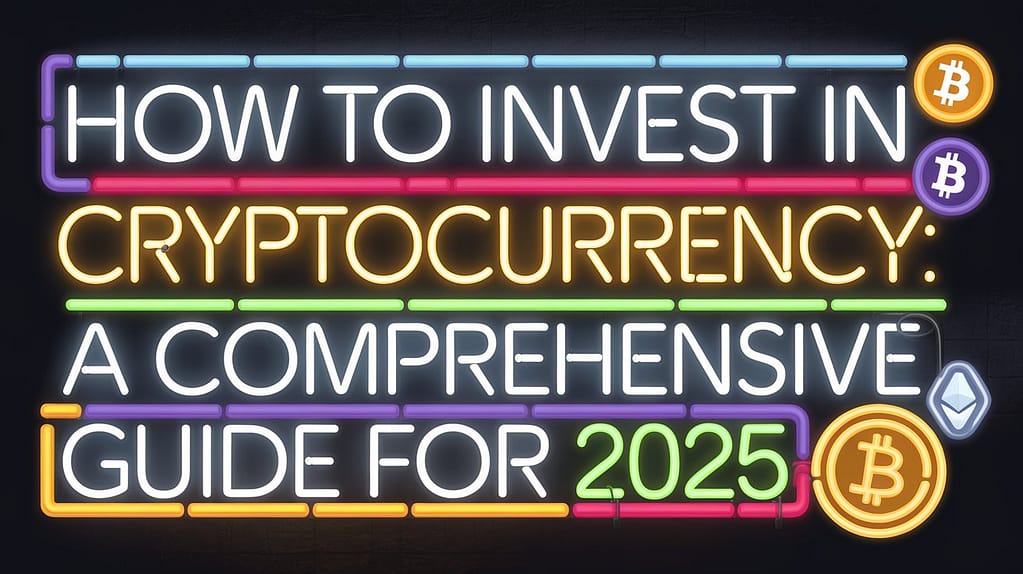
Introduction 🚀
Cryptocurrency represents a paradigm shift in global finance, challenging traditional banking structures through its decentralized nature. With the increasing adoption of digital assets across industries and the advancement of blockchain technology, understanding cryptocurrency investment is imperative for individuals seeking long-term financial growth. Whether you are an aspiring investor, a financial analyst, or an entrepreneur in India, this guide will elucidate the fundamental and advanced strategies necessary to navigate the evolving landscape of digital finance in 2025.
Objectives of This Guide:
- Develop a nuanced understanding of cryptocurrency fundamentals.
- Examine investment methodologies tailored for 2025’s market dynamics.
- Identify and mitigate risks associated with digital asset investments.
- Secure and manage crypto holdings with best-in-class security protocols.
- Understand the Indian regulatory framework and its implications for investors.
Conceptualizing Cryptocurrency: A Theoretical Framework 🧐
Cryptocurrency, a decentralized digital asset, operates on blockchain technology, ensuring transparency, immutability, and resistance to censorship. Unlike fiat currencies (INR, USD, EUR), cryptocurrencies are not governed by central banks, reducing counterparty risk and enabling permissionless financial transactions.
Core Attributes of Cryptocurrency:
- Decentralization: The absence of a central governing authority fosters autonomy.
- Global Accessibility: Transactions transcend geographical limitations.
- Immutable Ledger: Cryptographic hashing secures transaction history.
- Market Volatility: High price fluctuations create both opportunities and risks.
👉 Example: Bitcoin (BTC), Ethereum (ETH), and Solana (SOL) represent distinct use cases within the crypto ecosystem, including store-of-value, smart contract functionality, and high-speed decentralized applications.
(Insert a comprehensive infographic explaining blockchain ledger mechanisms.)
Understanding Blockchain Technology 🏗️
Blockchain, the foundational infrastructure of cryptocurrencies, operates as a distributed ledger system. Its decentralized consensus mechanisms (Proof of Work, Proof of Stake, Delegated Proof of Stake) ensure transactional integrity and network security.
The Blockchain Transaction Lifecycle:
1️⃣ Transaction Initiation: A sender authorizes a crypto transfer. 2️⃣ Validation Process: Network nodes verify transaction legitimacy. 3️⃣ Block Formation: Valid transactions aggregate into blocks. 4️⃣ Consensus Execution: The network achieves agreement via cryptographic protocols. 5️⃣ Blockchain Integration: The validated block appends to the immutable ledger.
(Insert an advanced process diagram illustrating consensus mechanisms.)
Evaluating Crypto Investment Viability in 2025 📈
The acceleration of Web3 technologies, institutional adoption, and the maturation of decentralized finance (DeFi) underpin the rationale for crypto investments.
🔥 Advantages:
✔ Asymmetric Return Potential – Historical appreciation of BTC from <$1 to over $50,000 underscores its wealth-generation capacity. ✔ Portfolio Diversification – Crypto functions as an alternative asset class, uncorrelated with traditional markets. ✔ Uninterrupted Market Access – Unlike stock exchanges, crypto markets operate continuously. ✔ Decentralized Ownership – Users retain sovereign control over their assets. ✔ Innovative Financial Instruments – DeFi, NFTs, and tokenized assets expand wealth-creation avenues.
🚨 Risks:
⚠ Extreme Price Volatility – Market corrections can lead to substantial drawdowns. ⚠ Regulatory Ambiguity – Government policies remain fluid and subject to change. ⚠ Security Breaches – Smart contract vulnerabilities and exchange hacks pose threats. ⚠ Speculative Nature – Informed decision-making is paramount to mitigate excessive exposure.
Strategic Framework for Crypto Investment 🛠️
1. Selecting a Reputable Cryptocurrency Exchange 🏦
Exchanges serve as primary access points for crypto transactions. Indian investors can utilize:
- WazirX – Beginner-friendly interface and robust liquidity.
- CoinDCX – Regulatory compliance and seamless fiat on-ramps.
- Binance – Advanced trading features with extensive asset selection.
- CoinSwitch Kuber – Simplified user experience.
- ZebPay – Legacy exchange with secure custodial solutions.
🔹 Best Practice: Prioritize exchanges with stringent security measures, transparent fee structures, and high liquidity.
2. Account Creation & Security Configuration 🔑
- Register with verified credentials.
- Complete Know Your Customer (KYC) verification for compliance.
- Enable Two-Factor Authentication (2FA) to enhance security.
3. Funding the Exchange Wallet 💰
- Investors can deposit funds using:
- ✅ UPI / IMPS / NEFT (India-centric fiat transactions)
- ✅ International Credit/Debit Cards
- ✅ Peer-to-peer (P2P) mechanisms for direct crypto procurement
4. Executing a Cryptocurrency Purchase 🚀
- Conduct market research before selecting an asset (e.g., Bitcoin, Ethereum, stablecoins).
- Utilize technical and fundamental analysis to time entry points.
- Implement market orders or limit orders for optimized execution.
5. Securing Crypto Holdings 🔒
Custodial responsibility is a critical component of digital asset investment. Storage options include:
- Hot Wallets: MetaMask, Trust Wallet – Suitable for frequent transactions.
- Cold Wallets: Ledger, Trezor – Ideal for long-term holdings with heightened security.
👉 Security Consideration: Never disclose private keys, and always enable multi-signature authentication.
Investment Methodologies 📊
📌 Long-Term Holding (HODLing)
Strategic retention of assets over extended periods to capitalize on macroeconomic appreciation trends. ✅ Applicable to Bitcoin, Ethereum, and blue-chip assets. ✅ Reduces exposure to short-term volatility.
📌 Dollar-Cost Averaging (DCA)
A systematic investment approach to mitigate market entry timing risk. ✅ Minimizes impact of price fluctuations. ✅ Particularly beneficial in volatile market environments.
📌 Staking & Yield Farming
Generating passive returns through blockchain-native financial mechanisms. ✅ Staking rewards from Ethereum 2.0, Solana. ✅ Yield farming opportunities in DeFi ecosystems.
Indian Crypto Taxation & Compliance 📜
Regulatory clarity remains a focal point in Indian crypto adoption. The government imposes: ✔ 30% Capital Gains Tax – Applicable to realized crypto profits. ✔ 1% TDS Deduction – Mandatory for all crypto transactions exceeding prescribed limits. ✔ Record-Keeping Obligation – Accurate transaction logs for compliance adherence.
Avoiding Investment Pitfalls ❌
⚠ Investing impulsively without due diligence 📉 ⚠ Engaging in fraudulent schemes 🛑 ⚠ Neglecting robust security practices 🔐 ⚠ Emotional trading during market downturns 📉 ⚠ Over-concentrating capital into a single asset 🚨 ⚠ Speculative trading without fundamental evaluation 🚨
Conclusion 🎯
Cryptocurrency investment in 2025 offers substantial opportunities for wealth accumulation. However, success necessitates comprehensive knowledge, strategic foresight, and disciplined execution. By adhering to the methodologies outlined herein, investors can confidently navigate the crypto landscape.
👉 Next Steps:
- Initiate small-scale investments with structured risk management.
- Stay abreast of evolving crypto trends (DeFi, Metaverse, Web3).
- Engage in reputable investment communities for knowledge-sharing.
📢 Questions? Engage with us in the discussion below!


My developer is trying to persuade me to
move to .net from PHP. I have always disliked the idea
because of the costs. But he’s tryiong none the less. I’ve been using Movable-type
on various websites for about a year and am worried about switching to another platform.
I have heard great things about blogengine.net. Is there a way I can transfer
all my wordpress content into it? Any help would be greatly
appreciated!
Moving from PHP (especially WordPress) to .NET-based platforms like BlogEngine.NET can be a significant transition. Here are a few things to consider before making the switch:
1. Costs & Hosting
WordPress (PHP): Free, open-source, and has affordable hosting options.
.NET (BlogEngine.NET): Requires a Windows-based hosting environment, which may be more expensive than typical Linux-based WordPress hosting.
2. Content Migration
Yes, it is possible to migrate your WordPress content to BlogEngine.NET, but it requires some work. Here’s a general approach:
Method 1: Using BlogML Export/Import
Install a WordPress plugin that exports posts in BlogML format.
Export all your posts, pages, and comments.
Use BlogEngine.NET’s import feature to upload the BlogML file.
Method 2: Manual Export & Import
Export WordPress content as XML using the built-in WordPress exporter.
Convert the XML file to BlogEngine.NET’s compatible format.
Import the content manually into BlogEngine.NET.
3. Alternative Solutions
If your main concern is performance and scalability, you don’t necessarily have to switch to .NET. Consider:
WordPress with caching and optimization
Headless WordPress with .NET as a frontend (keeps the best of both worlds)
If your developer is pushing for .NET due to security or performance, you might want to evaluate whether those issues can be addressed within WordPress itself before making the jump.